The principles of modern design are all about geometry, long lines, restrained color, and flawless detailing. The paver selections contribute to the visual heavy lifting: they set the stage, control light and shadow, and determine how “crisp” the space feels. Our team is uniquely equipped to help with the best selection – whether your architecture leans Scandinavian, desert-minimal, or simply contemporary.
What “Modern” Looks Like Outdoors
Modern hardscapes share a few visual signatures:
- Large formats & long planks to minimize joints and emphasize horizontality.
- Smooth or lightly textured faces, staying clear or tumbled edges.
- Monochrome or tonal palettes including graphite, onyx/charcoal, greige, limestone-light.
- Simple laying patterns like stack bond, running bond, and modular grids.
- Shadow-line discipline showcased in tight jointing, straight edges, flush transitions.
Our preferred vendor is Techo-Bloc and their catalog is unusually strong in these areas, offering multiple slab and paver families that deliver crisp edges, HD2 ultra-smooth finishes, and modern colorways.
Techo-Bloc Product Families That Excel in Modern Patios
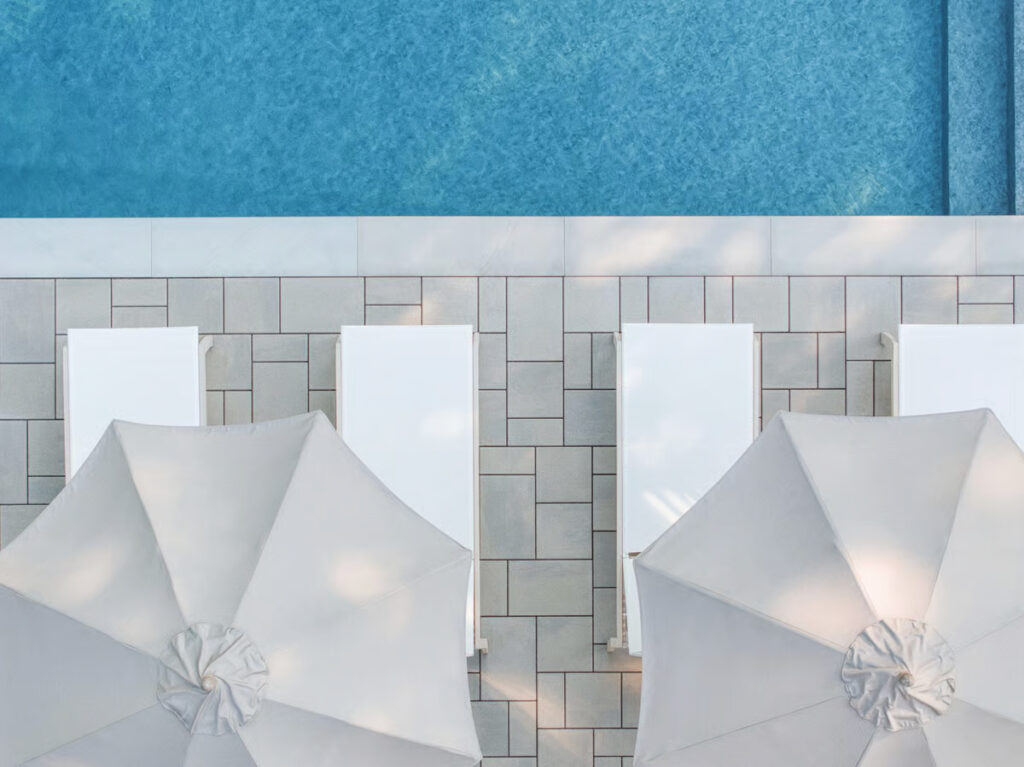
1. Blu 60 / Blu Grande (Smooth & HD2)
Why it reads modern: Big, confident modules with sleek surfaces and precise edges create an architectural, gallery-like floor. The HD2 finish tightens the surface for a refined look.
Best for: Primary patio surfaces, dining terraces, areas that abut large sliding doors where you want an “indoor tile” vibe outdoors.
Go-to patterns:
- Stack bond in a single large size for a gallery slab effect.
- Modular grid (mix sizes within Blu 60) to add subtle interest while staying rectilinear.
Color tips: Charcoal/Onyx for high contrast with pale stucco; Greyed neutrals for continuity with modern siding and concrete.
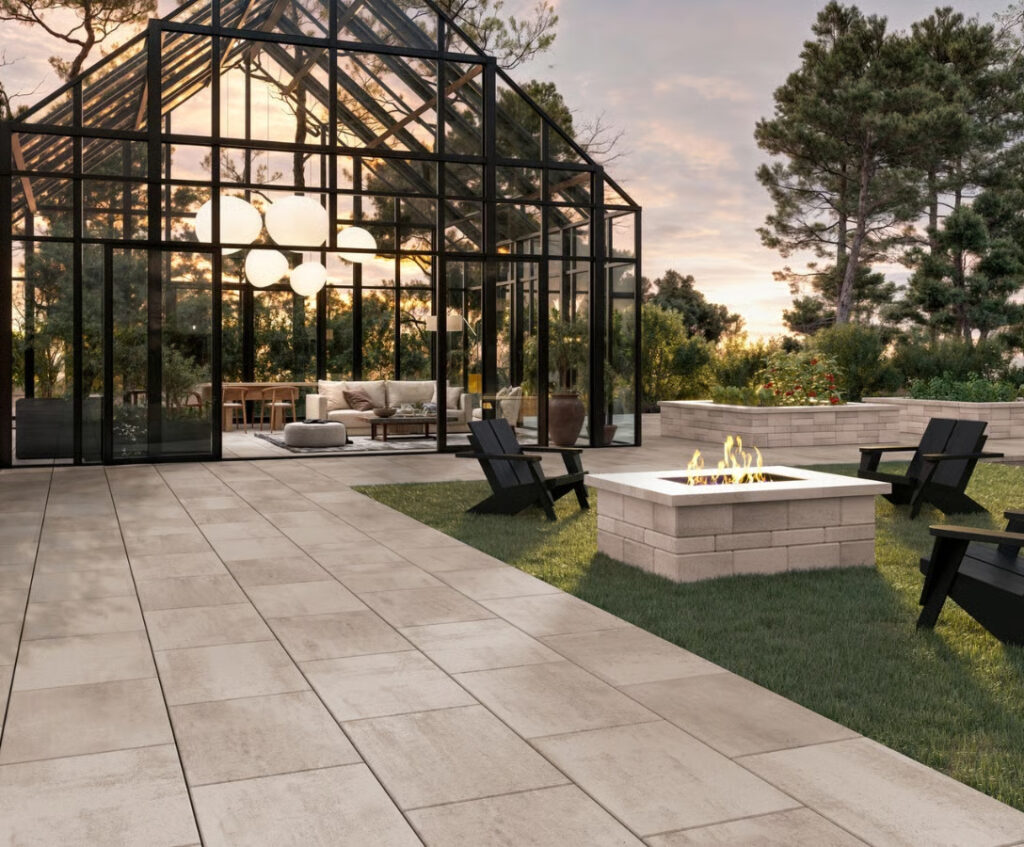
2. Industria (Smooth / Granitex)
Why it reads modern: A true “architectural paver” system – rectilinear, modular, and available in multiple formats and faces. Smooth skews ultra-modern; Granitex adds a fine mineral tooth without looking rustic.
Best for: Courtyards, roof terraces, and mixed-use patios where you want rhythmic grids, accent bands, or to echo window mullion patterns.
Go-to patterns:
- Monochrome running bond for quiet minimalism.
- Two-tone modular grid (one color field + darker border band) for subtle zoning.
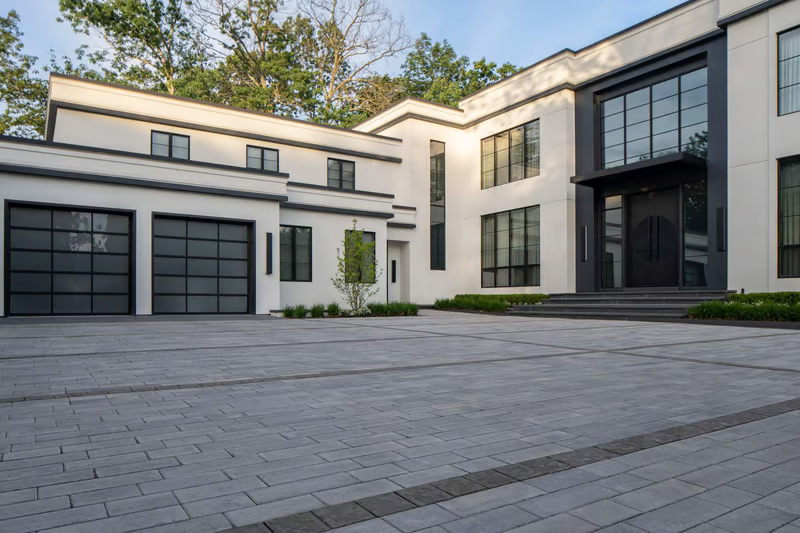
3. Linea (Long Planks)
Why it reads modern: Lean, elongated profiles create strong directional flow – perfect for lengthening small yards or drawing the eye to a focal tree, pool, or fire feature.
Best for: Path-to-patio transitions, side yards, and terraces where you want timber-plank vibes without wood maintenance.
Go-to patterns:
- Linear running bond oriented along the long axis of the space to “stretch” it.
- Herringbone (tight) for a contemporary parquet feel (keep color monotone).
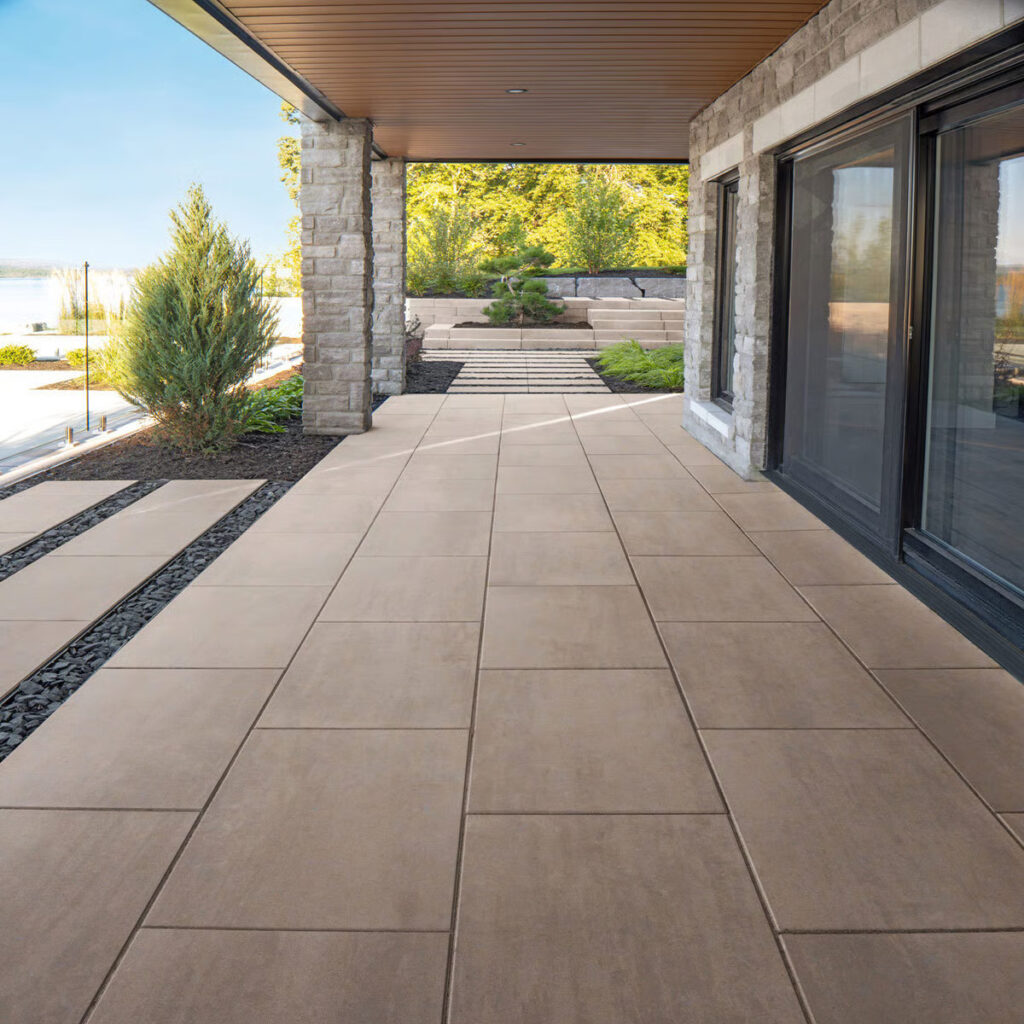
4. Para HD2 (Rectilinear Elegance)
Why it reads modern: A crisp, fine-grained face with precise rectangles that feel deliberately “architectural.” The HD2 surface yields an upscale, indoor-adjacent finish outdoors.
Best for: Formal dining terraces, covered outdoor rooms, or anywhere furnishings are sleek (powder-coat frames, taut cushions).
Go-to patterns:
- Stack bond with a continuous 90° grid for a museum-like field.
- Running bond paired with a contrasting ½-inch border soldier course.
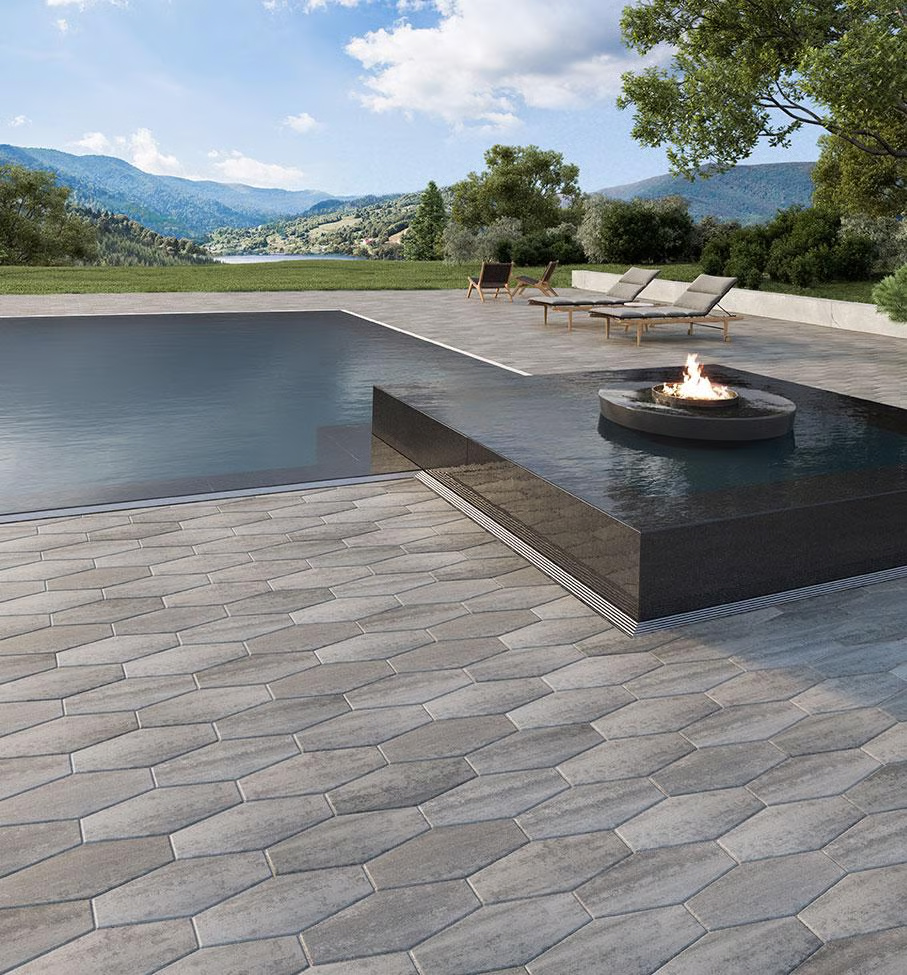
5. Hexa (Geometric Statement)
Why it reads modern: Honeycomb geometry is quintessentially contemporary and can read playful or serious depending on color.
Best for: Feature zones (fire lounge, entry court), inset “rug” fields, and small patios where pattern is the protagonist.
Go-to patterns:
- Monotone hex field for texture without visual noise.
- Two-tone gradient from light to dark to animate a focal area.
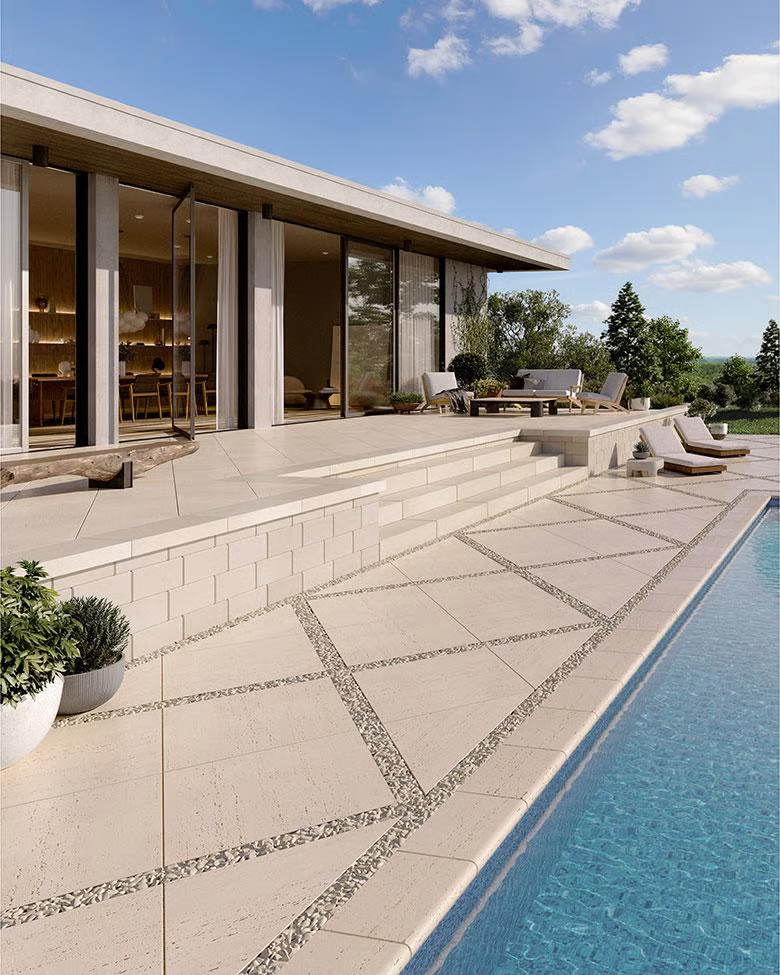
6. Travertina Raw (Slab)
Why it reads modern: Delivers the warmth and veining of travertine in a large, rectified slab format – more boutique-hotel than old-world villa when used monochromatically and with tight joints.
Best for: Covered patios, poolside lounging decks, and spaces seeking a soft, resort-modern character.
Go-to patterns:
- Large-format stack bond to celebrate slab scale.
- Picture-frame border in a slightly darker tone for subtle definition.
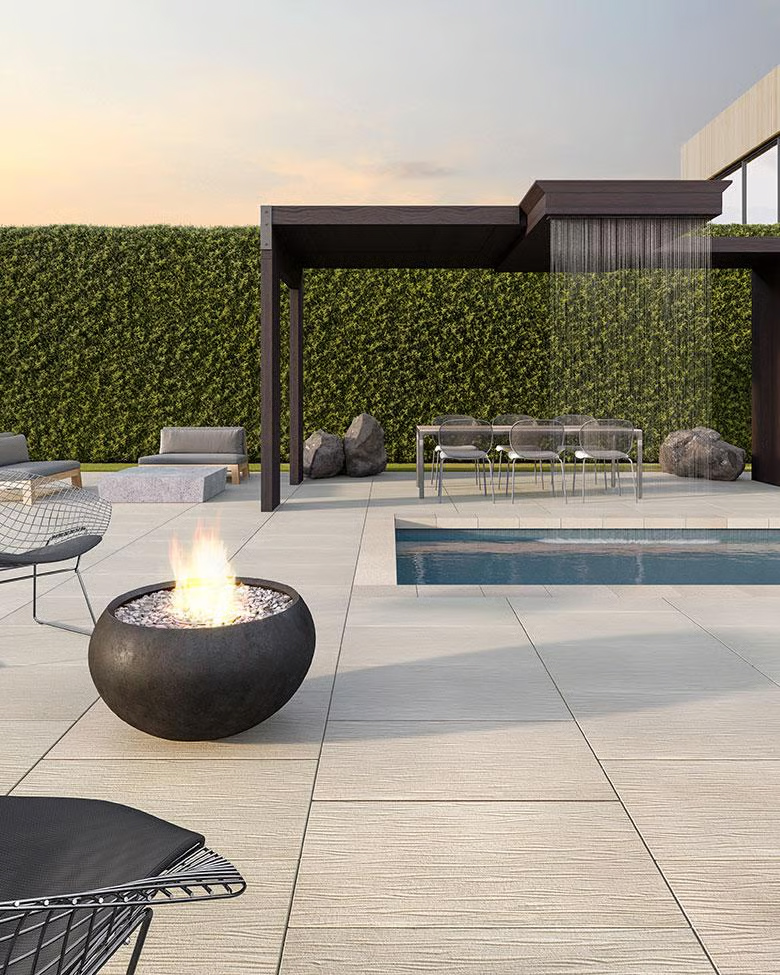
7. Ocean Grande (Oversized Pool-Friendly Slab)
Why it reads modern: Expansive size and refined texture read as high-end stonework, especially around water where visual calm matters.
Best for: Pool decks, sun shelves, and contiguous dining patios where continuity of slab matters.
Go-to patterns:
- Uniform stack bond with extra-precise alignment and drainage planning.
Color Strategy: Four Foolproof Modern Palettes
- Charcoal on Charcoal
Blu 60 (Smooth) in an onyx black field + matching charcoal border. Works with black windows, cedar accents, and corten planters. - Soft Concrete Greige
Para HD2 or Industria Smooth in warm-grey to keep glare down and pair with beige limestone or sand-tone stucco. - Monochrome Light Limestone
Travertina Raw or Ocean Grande in a pale tone for airy, Mediterranean-modern spaces (great with olive trees and grasses). - Two-Tone Graphite + Mid-Grey
Industria modular field in mid-grey with a narrow black soldier course to frame and sharpen edges.
Practical Selection Checklist
- Format first: Start with the scale you want (large slab vs. long plank), then shortlist families that offer those modules (Blu, Para HD2, Industria, Linea, Ocean Grande).
- Finish & foot feel: Choose Smooth/HD2 for indoor-adjacent spaces; lightly textured faces for pool decks and freeze-thaw resilience.
- Color discipline: Limit to one field tone + one border tone. If using a feature pattern (Hexa), keep it within the same palette.
- Pattern proof: Dry-lay a 6’×6′ mockup to confirm the visual rhythm against façade lines and door thresholds.
Our professional design services combine style with durable products to construct a high-quality patio. Functionality of outdoor spaces takes a few key important considerations, including spacing and positioning, texture selection, and the use of green space. From the initial consultation to the end result, our patio construction team at Setting Sun will help answer your questions and guide you through the space creation process.